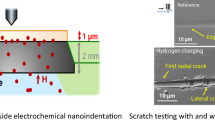Abstract
In this paper, the influence of various pre-oxidation cleanings on the Si/SiO2 interface and the oxide surface roughness is investigated. Different types of Vapor Phase Cleanings (VPC) are performed in an integrated STEAG AST cluster module and are compared to a standard wet cleaning process. The VPC uses Anhydrous Hydrogen Fluoride (AHF) and additional ozone cleaning. Directly after the cleaning, oxidation in pure oxygen (O2) is carried out in an integrated STEAG AST Rapid Thermal Processing (RTP) cluster module. Nitrided oxides are formed by annealing in pure nitric oxide (NO) gas directly after the oxidation. The nitrogen incorporation and distribution in the oxide is investigated using secondary ion mass spectroscopy (SIMS). The nitrogen concentration at the Si/SiO2 interface depends on the time and/or temperature of the NO annealing. For a 900°C annealing, the nitrogen incorporation varies from 0.5 at.% for a 5 s anneal to 2.5 at.% for a 60 s anneal. The nitrogen concentration of the oxides can be correlated with the different types of precleaning sequences which seems to be an effect of the different fluorine contents obtained after various cleaning procedures. The surface roughness of oxide layers formed after different pre-cleaning sequences is analyzed by Atomic Force Microscopy (AFM). A decrease in surface roughness is measured for oxidation performed at higher temperature. and for rapid thermal oxides produced after a cleaning procedure using AHF and ozone.
Similar content being viewed by others
References
Cleaning and Contamination Monitoring Systems for the Semiconductor Industry (San Jose, CA: VLSI Research, Inc., April 1986).
J. Ruzyllo, Microcontamination 6, 39 (1988).
M. Bhat, L.K. Han, D. Wristers, D.L. Kwong, and J. Fulford, Appl. Phys. Lett. 66, 1225 (1995).
B. Froeschle, N. Sacher, F. Glowacki, and T. Theiler (Paper presented at the E-MRS Spring Meeting, Strasbourg, France, June 1998).
A.B. Joshi, G.Q. Lo, J. Ahn, W. Ting, and D.L. Kwong, SPIE 1595, 177 (1991).
B. Froeschle, F. Glowacki, I. Kasko, R. Oechsner, A. Bauer, and C. Schneider, Proc. 192nd Electrochem. Soc. Mtg. 97-35 (New York: Electrochem. Soc., 1997), p. 415.
I. Sagnes, D. Laviale, F. Martin, F. Glowacki, and L. Deutschmann, Transient Thermal Processing Techniques in Electronic Materials, ed. N.M. Ravindra and R.K. Singh (Warrendale, PA: TMS, 1996), pp. 49–53.
John M. Grant, Materials Research Society Symp. Proc. Vol. 387 (Warrendale, PA: MRS, 1995), pp. 175–186.
Author information
Authors and Affiliations
Rights and permissions
About this article
Cite this article
Sacher, N., Froeschle, B. & Glowacki, F. The influence of vapor phase cleaning on the composition and the surface roughness of rapid thermal oxides and nitrided oxides. J. Electron. Mater. 28, 1365–1369 (1999). https://doi.org/10.1007/s11664-999-0123-x
Received:
Accepted:
Issue Date:
DOI: https://doi.org/10.1007/s11664-999-0123-x




